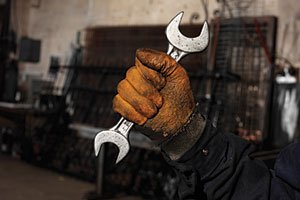
|
|
Photo credit: ©istockphoto.com/kemalbas |
I was fortunate to grow up in a family where both of my parents lived through the Great Depression of the 1930s. Surviving during that period of American history established strong traits in both my mother and father. Neither was very keen on throwing away anything but absolute garbage.
In particular, my father was a champion of the “waste not/want not” ideology. He was born in 1901 and was 55 years old when my twin brother and I arrived.
My father grew up on a dairy farm and then learned how to be one of the first electricians in rural upstate New York. Eventually he taught himself how to build cabinets, install plumbing, lay blocks and even build entire houses.
He was a proud owner of the set of The Practical Handyman’s encyclopedias that sat on display in a bookcase he built in the living room of the house that he also framed, roofed, plumbed, wired and trimmed.
That house sported a vintage 1954 Iron Fireman SelecTemp steam-heating system. At the time, this approach was a radical departure from traditional steam heating. Steam was delivered to each wall-mounted convector through 1/4-in. soft-temper copper tubing. Condensate returned to the boiler though 1/8-in. copper tubing. The pressure of the entering steam was used to spin a very small turbine inside each convector. The turbine shaft connected to a small blower wheel that pushed air through the coil. My dad put it all together and kept it running.
Fond memories
The project I remember best was when my dad, who was in his late 60s, salvaged the pedal-powered John Deere toy tractor my brother and I had outgrown. He combined the toy with the guts from an old gasoline pump and an old lawnmower engine to make a gas-powered insecticide sprayer for our fruit trees.
This rig got towed behind the lawn tractor. It allowed him to keep tending those trees without lugging around gallons of spray on a back that had paid its dues over many decades of hard work.
College prep
Watching, and many times participating in my father’s projects, was one of the best preparations my brother and I could have had for eventually becoming engineers. I didn’t realize it at the time. Quite the contrary, I thought that some of the recycling efforts my father used to make old things do new tricks were just a way to use up time in semiretirement, especially when he could have just bought something for the same purpose.
Now, I know that my father’s bootstrap engineering was often far more creative and a lot less costly than some other product-development efforts I’ve witnessed. It was also pretty darn “green” by today’s standards.
Plan A and Plan B
I grew up about 10 miles from Rome, N.Y., then home to Griffiss Air Force Base. At the time, Griffiss was a strategic air command base ready to respond to a doomsday scenario if necessary. During the 1960s it was common to see bombers and jetfighters flying over our house, sometimes at speeds that created sonic booms.
Growing up around all this air power really kindled my interest in airplanes. My career ambition during high school was to become a fighter pilot, but the Air Force had a problem handing the keys for a jet to anyone with less than 20/20 vision.
So when I graduated high school in 1974, I settled for Plan B; designing airplanes. I was one semester away from a degree in aeronautical engineering when I finally realized that most of the associated jobs would take me a long way from where I grew up and where my soon-to-be wife and I had our roots.
The next sunrise
At about the same time, my father was getting interested in solar-energy systems. He would read about them every month in Popular Science magazine. I’m sure he was formulating a plan on how he could build his own collectors and put them up on our roof.
I started looking over my dad’s shoulder at these solar-heating systems and had one of those “light bulb” moments: I realized that the thermodynamics, fluid mechanics, heat transfer and mathematics I’d been studying could apply to something other than designing airplanes. I became increasingly interested in home-heating systems, especially those involving solar collectors. Any time not devoted to finishing up that last semester usually found me sketching ideas for a solar-heated house I planned to build for my new wife — like my father did for his wife.
In 1980, I got started on building that house. My wife and I spent our second anniversary nailing 2-by-12 floor joists in place for the floor deck. We moved into a barely habitable shell in November 1980 and kept working toward finishing the house. In the process, I got much better at what I had watched my father do, but consciously had not taken too seriously as a teenager. I framed, finished, plumbed, wired, laid bricks, finished drywall, built kitchen cabinets and assembled my first solar-thermal combisystem.
My father passed away in 1978 and never got to see any of this. Still, if the years separating us had been fewer, I suspect he would have been right there beside me pounding nails to create a “solar house” that might even look good on a cover of his favorite magazine.
Plenty of mistakes were made along the way. Some of my home-brew energy experiments worked and some didn’t. Some have since been shut off and removed while others just “keep on tickin” like a Timex watch.
Having a chance to build things, both as a child playing with leftover materials and a young man trying to build his first house, was immensely helpful in improving what I now do as an engineer. It revealed the “big picture” of how structure, insulation, windows, building orientation, shading and thermal mass all interact with the home’s heating system.
It also reinforced the reality that despite correctly doing the calculations, theory doesn’t always predict what happens in the field. It taught me how to deal with the reality of construction, vs. the sterile number-crunching often associated with engineering courses. I learned to maintain a balance between the two, using sound scientific principles and practical experience to guide decision making.
iWork
If you know a young person who’s thinking about a career in building or HVAC design, encourage them to get involved in projects where they’re forced to get their hands dirty, where they learn firsthand what a day on a construction crew is like and where they see that everything they design in AutoCAD or SolidWorks doesn’t always come together as planned onsite.
They will learn how to deal with things such as crooked lumber, shorted wiring, bent tubing, surfaces that are not level and plumb, and materials that just don’t look and perform on a jobsite like they do in advertisements.
After 27 years of teaching at a community college, I’ve worked with plenty of young people who planned careers in engineering or technology. But, they’ve had little, if any, opportunity to get their hands dirty building or repairing things before arriving at college. Many of them could deal with things such as an electrical schematic on paper, but could not physically assemble the same circuit using real hardware.
Most had no idea that a standard 2-by-4 measures 1.5 in. by 3.5 in, that a concrete block is 3/8-in. shorter than its nominal dimensions in all directions, or how to strip and attach two wires with a wire nut. I doubt any of them had ever burned their hand on a hot solar collector, stepped on a drywall ceiling from the attic side, fallen off an improperly placed ladder or accidentally cut through a live electrical wire.
Some educators think that all such bloopers are avoidable if we force young people to read about them in textbooks or perhaps simulate them on an iPad. From my perspective, there’s no substitute from true hands-on learning, especially when it makes you dirty, sweaty, tired and sometimes scares the you-know-what out of you.
Pick up a hammer
If you’re a young person aspiring to design buildings, heating systems or maybe even airplanes, put down your smartphone for awhile. Take out a sheet of paper and draw something you want to see created.
If you don’t know how to draw, check out a book on drafting, learn how to sketch and draw in ways that can properly communicate your ideas to others. Take pride in making those drawings.
During summer break, find a contractor who is willing to let you work on a construction crew. It’s not about the money you’ll earn, it’s about experiencing what it takes to create something as complex as a building. You’ll likely feel whipped after a long, hot day on a construction site, but that experience will be invaluable.
Take pride in your labor and what you helped build. If it doesn’t come out as expected, find out what went wrong and do it over the right way. It may not be evident at the time, but every day on such a job will make you a better designer, technician or engineer.



